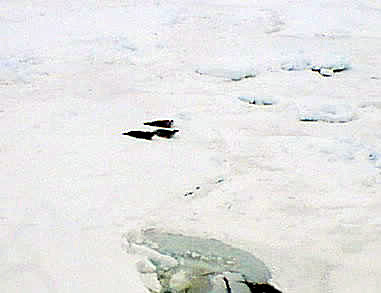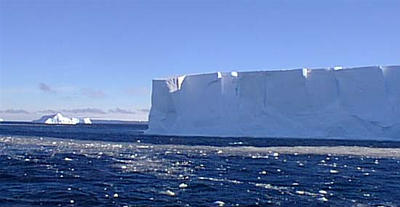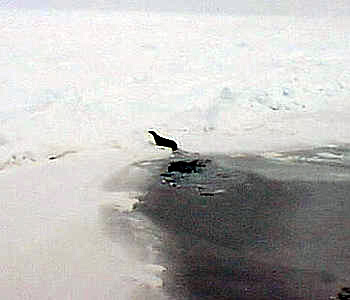27 February, 1999
February 27, 1999
Hi from the Nathaniel B. Palmer. What a great day we had today! It
started off with lots of sunshine and blue skies. Not too long after we
started our shift, the Mate from the bridge called down and told us to look
at the iceberg on the port (left) side of the ship. PJ and I ran out first
. . . it was over 100 feet high! Then, we went back inside so Ashley and
Broxton could go out and look at it. The iceberg was fairly close to the
ship, and it was awesome! Later this afternoon, the clouds started to roll
in. Tonight, the winds are blowing and the skies are dark. We did
however, have another beautiful sunset.
We arrived at the Getz Ice Shelf late this morning and have spent the day
conducting multibeam surveys of the area. Tomorrow, we hope to begin some
seismic lines and possibly get out the deep tow. The "fish" for the deep
tow is completely fixed now, and I'm hoping we get to use it on our shift
sometime soon. The Getz Ice Shelf is over 300 miles long and from 20 to 60
miles wide. It borders the Hobbs and Bakutis coasts of Marie Byrd Land,
and includes several large islands that are wholly or partially embedded in
the ice shelf. This ice shelf wasn't even discovered until the United
States Antarctic Service found it in 1940. It was named for George Getz,
who helped furnish the seaplane for the expedition. Today, we realized
just how infrequently people actually get into this area. There is a huge
mountain nearby named Mt. Siple. It stands over 10,000 feet tall, and we
were able to get within a couple of miles from its base. Well, it's actual
location turns out to be at least 20 miles different from it's location on
our map. We've also found several islands that aren't mapped correctly on
our charts. I guess our maps were made before GPS!
Yesterday's question was, "What do you suppose Crabeater seals eat for
dinner?" I bet you figured out that it wasn't crab! Actually, Crabeater
seals eat mostly krill, which are shrimplike crustaceans that live in the
water. They probably got their erroneous name because of some confusion
when translating their name from the Scandinavian languages. Crabeater
seals are the most abundant seals in the world. Their total population is
estimated at more than 15 million animals. They can be as long as eight
and a half feet, and can weigh up to 500 pounds. When you look at
Crabeater, however, they appear rather slim. These seals are almost never
found on the land. They prefer to live in the pack ice as long as they
have access to open water.
There are five other species of seals that can be found in Antarctica. Of
the six total species, the Fur seal is the only eared seal in the
Antarctic. Fur seals don't actually live near the continent, however.
They live on the tip of the peninsula and on the sub-Antarctic Islands.
During the 1800s, these seals were hunted for their skins. They were
nearly forced into extinction; but they are protected today, and their
population is increasing in number each year.
All the other species of seals (including the Crabeater) are earless and
insulated by blubber rather than fur. The Southern Elephant seal is the
largest seal and it breeds on the sub-Antarctic islands. Bulls can grow to
14 1/2 feet in length and weigh four tons. Southern Elephant seals eat
mainly squid, although they also eat some fish. Their blubber can be up to
six inches thick, which helps them spend most of their lives in the cold
water.
Leopard seals have longer faces than the other seals around here, and they
are known as one of the penguin's greatest enemies (along with killer
whales). They get their name from the "leopard spots" on the throat,
shoulders, and sides. They can grow to over 11 feet long and weigh up to
800 pounds. Usually, leopard seals are solitary animals. Actually, these
seals eat a wide variety of foods. Penguins are only a portion of their
diet. About one third of their food consists of fish and krill, and they
also eat other seals (especially young Crabeaters).
Ross seals are fairly rare, and they are the most recently discovered
pinniped. Pinnipeds are carnivorous mammals in which all four limbs have
been modified into flippers. Captain James Clark Ross first discovered
Ross seals during the British Antarctic Expedition of 1839-43. Ross seals
average about six to seven feet in length and weigh around 400 pounds.
They live only in deep pack ice, and they are known as solitary animals.
Not very much is known about them, but scientists believe that squid make
up most of their diet, with fish and krill making up the remaining portion.
The last type of seal is the Weddell seal. We saw lots of Weddell seals as
we were flying into McMurdo Station. They are the most southerly mammal in
the entire world, and they live almost exclusively in regions of fast ice.
Weddell seals are nine to ten feet in length, and weigh around 1000 pounds.
They are one of the larger seals, and have a really neat adaptation for
storing lots of oxygen so that they can remain under the water for a long
period of time. Most dives last about 15 minutes, but they are able to
stay under water for an hour or more if necessary. Mostly, they are diving
for their favorite dinner . . . the giant Antarctic cod. They also eat
crustaceans and squid.
Today I received a phone call from the bridge that there were whales
outside! I ran up to get a good look, and I saw at least five orcas
(killer whales). What other types of whales can be found in Antarctica?
We'll look at that in tomorrow's journal. See you then!
Kim Giesting
Latitude: 74 degrees 18 minutes South
Longitude: 128 degrees 33 minutes West
Temperature: -9 degrees C
Barometer: 980.0 mb
Wind Speed: 40.8 knots
Wind Direction: 90 degrees (from the East)
Sunrise: 23:36
Sunset: 16:06

Here are three Crabeater seals sitting on a piece of sea ice.

This iceberg is over 100 feet high.

I watched this Crabeater seal jump out of the water and up on the ice.
Contact the TEA in the field at
.
If you cannot connect through your browser, copy the
TEA's e-mail address in the "To:" line of
your favorite e-mail package.
|
